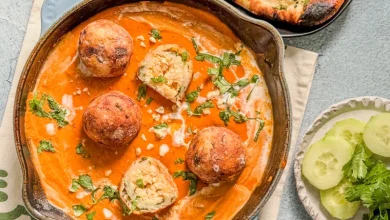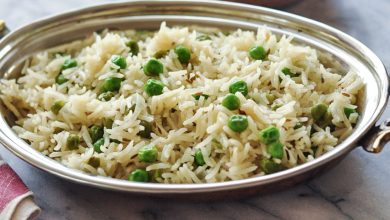Phalguni Dal Recipe: A Bengali Delight
Phalguni Dal is a traditional Bengali recipe that combines the rich flavors of lentils, spices, and vegetables, making it a nourishing dish perfect for lunch. This high-protein vegetarian recipe is packed with flavor and nutrition, featuring masoor dal (lentils), green peas, and a variety of aromatic spices. The dish pairs wonderfully with roti or rice, and is a delightful addition to any meal. Here’s a detailed step-by-step guide on how to prepare Phalguni Dal.
Ingredients
| Ingredient | Amount | Notes |
|---|---|---|
| Masoor dal (lentils) | 1/4 cup | Wash thoroughly before use |
| Green peas | 1/4 cup | Fresh or frozen |
| Onion | 1, finely chopped | |
| Tomato | 1, finely chopped | |
| Ginger | 1/2 inch piece, grated | |
| Garlic | 2 cloves, grated | |
| Green chilies | 2, chopped | |
| Turmeric powder | 1/2 tsp | |
| Salt | As per taste | |
| Mustard seeds (Rai) | 1 tsp | |
| Fenugreek seeds | 1/4 tsp | |
| Cumin seeds | 1/2 tsp | |
| Fennel seeds | 1/2 tsp | |
| Kalonji (Nigella seeds) | 1/4 tsp | |
| Garam masala powder | 1 tsp | |
| Mustard oil | 2 tsp | |
| Asafoetida (Hing) | A pinch | |
| Fresh coriander (for garnish) | As needed |
Preparation Time
| Step | Time |
|---|---|
| Preparation | 10 minutes |
| Cooking | 20 minutes |
| Total Time | 30 minutes |
| Servings | 2 |
Cuisine
- Cuisine: Bengali
- Course: Lunch
- Diet: High Protein Vegetarian
Instructions
Step 1: Preparing the Dal
To begin preparing Phalguni Dal, thoroughly wash the masoor dal (lentils) under running water. In a pressure cooker, combine the washed lentils with finely chopped tomatoes, onions, grated ginger, grated garlic, and 1 1/2 cups of water. Secure the lid and cook on medium heat until you hear three whistles from the pressure cooker. Turn off the gas and allow the pressure to release naturally. Once the pressure has released, open the cooker and gently mash the cooked dal. Set it aside for later use.
Step 2: Preparing the Tempering (Tadka)
In a separate pan or kadhai, heat 2 teaspoons of mustard oil over medium heat. Once the oil is hot, add the mustard seeds (rai), fenugreek seeds, fennel seeds, cumin seeds, and kalonji (nigella seeds). Let them crackle for a few seconds. This step is crucial to release the essential flavors of the spices.
Next, add the chopped green chilies to the pan and sauté for 1 minute, allowing their heat to infuse the oil. Then, add a pinch of asafoetida (hing) and turmeric powder to the pan. Stir well to combine the spices and cook for another minute.
Step 3: Cooking the Vegetables
Add the fresh or frozen green peas to the pan and stir them with the spices. Cover the pan and cook for about 2 minutes on medium heat. This allows the peas to cook and absorb the aromatic spices.
Step 4: Combining Dal and Tempering
Once the peas have softened, add the mashed dal (from Step 1) to the pan. Stir well to combine the dal with the tempering and vegetables. Add salt to taste and garam masala powder. Mix everything thoroughly and let it cook for another 3 to 4 minutes. This step helps all the flavors meld together.
Step 5: Garnishing and Serving
Once the dal is well-cooked and the flavors have blended together, turn off the heat. Garnish with freshly chopped coriander leaves for an added burst of color and freshness.
Serve Phalguni Dal with steamed rice, phulka (Indian flatbreads), or alongside Bhindi Masala and Bundi Raita for a wholesome Bengali lunch experience.
Tips and Variations
- For a creamier texture, you can add a splash of milk or coconut milk while cooking the dal.
- You can increase or decrease the number of green chilies according to your heat preference.
- To add a touch of sweetness, a small piece of jaggery can be added to balance the flavors.
Nutritional Information
| Nutrient | Amount per serving |
|---|---|
| Calories | 190 kcal |
| Protein | 9 g |
| Carbohydrates | 30 g |
| Fiber | 7 g |
| Fat | 7 g |
| Sodium | 500 mg |
Phalguni Dal is an excellent choice for a high-protein vegetarian meal that offers a good balance of essential nutrients. Its combination of lentils, peas, and spices makes it both satisfying and flavorful. Whether you’re following a vegetarian diet or simply looking to try something new, this Bengali recipe will surely be a hit at your table. Enjoy!




